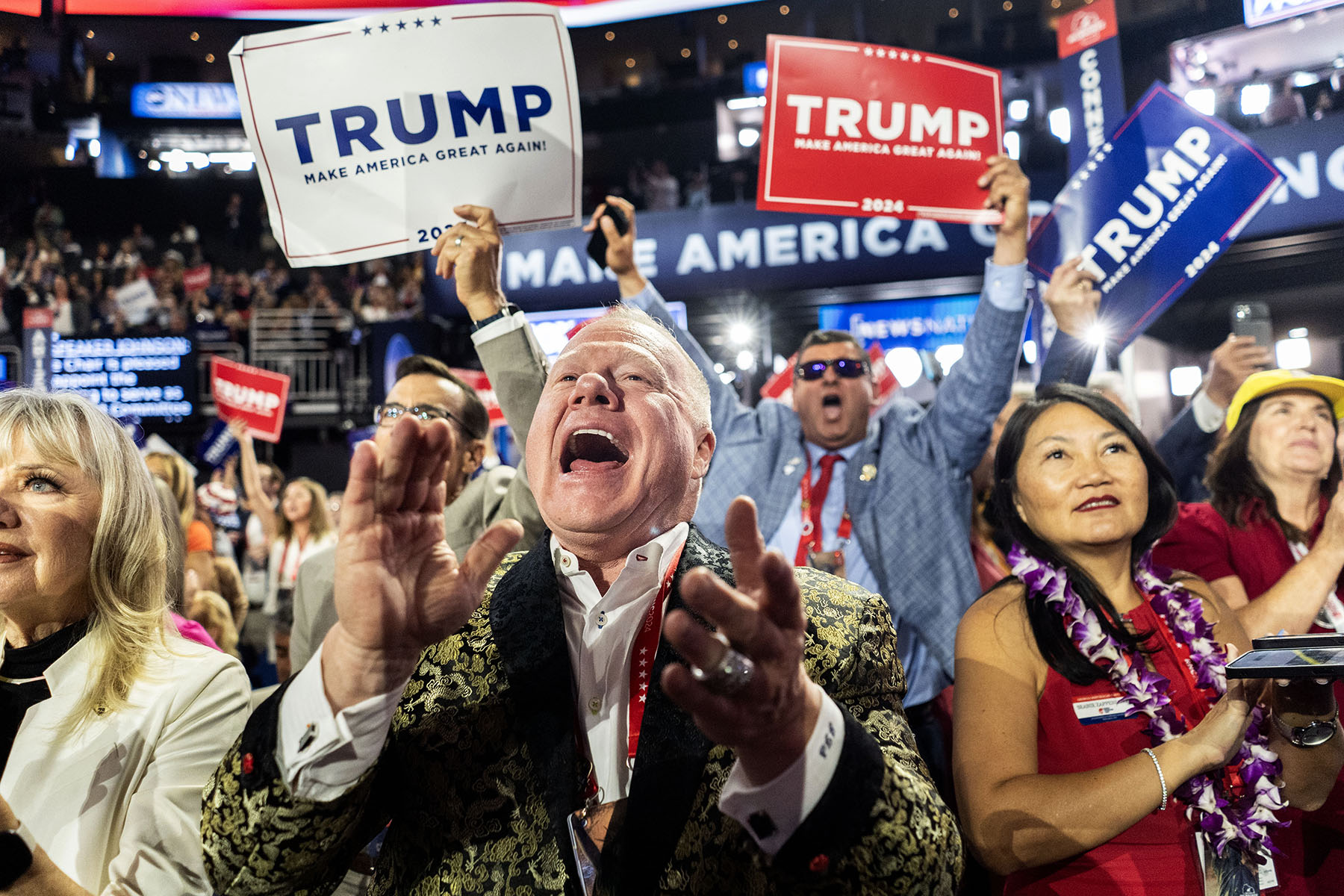This column first appeared in The Amendment, a biweekly newsletter by Errin Haines, The 19th’s editor-at-large. Subscribe today to get early access to future analysis.
MILWAUKEE — Two Americas were on display this week, and I was in one of them, at the Republican National Convention.
Here, Republicans are very excited about November. They wish the election was today. They love their candidate. They walked around draped in various flag-themed fashions, in shades of MAGA red, perusing vendor booths selling merchandise with images of Donald Trump or messages in support of their nominee. On one T-shirt: “I’m Voting for the Felon 2024.”
For a week, they got to be one nation under Trump.
“It was like a giant party,” said Kylie Jane Kremer, the executive director of Women for America First who was the host of the Save America Rally ahead of the January 6, 2021, insurrection. “A lot of new people are coming to the party. It’s growing to become much more of a big tent. There was a lot of unity after Republicans not being in power for four years. It was a celebration.”
Outside of the convention, Democrats are contemplating the future of their party and their previously presumed, now embattled nominee. The mood is decidedly not excited, but one of uncertainty, handwringing, despair and disarray. Three weeks after a disastrous debate performance by President Joe Biden raised questions about his electoral viability, Democrats are still debating.
For Republicans, Trump’s near-death experience has only confirmed his electoral virility, as the shellshock of last weekend gave way to an air of inevitability.
The mood in Milwaukee isn’t just festive; it’s celebratory. The women here are proud and excited about Trump and eager to vote for him. The message from primetime speakers was one of democracy, patriotism and inclusion. The mainstream media, they said, doesn’t understand them — or know the Trump that they know: a fighter, compassionate, courageous, full of conviction and committed to serving the American people.
There is also a dissonance here. The America the GOP talked about on stage is not reflected in the actual party or the messaging to their base. The crowd was overwhelmingly White men, yet there was talk of diversity and support for women. There was no mention of abortion, though it was Trump’s presidency that ushered in the Supreme Court that ended federal protections for abortion.
Headed into Milwaukee, just 48 hours after the party’s nominee was nearly killed onstage at a campaign rally, it was unclear what the mood would be in the city or among the attendees. But as the delegates gathered Monday, it didn’t take long for the vibes to become clear.
The focus wasn’t on national unity, but on uniting the Republican Party. Past fights gave way to solidarity and unwavering support for Trump, who emerged nightly to preside over the primetime program. He was greeted with cheers as the audience chanted “Fight! Fight! Fight!” — the rallying cry the former president gave as he rose to his feet on Saturday, moments after a gunman made an attempt on his life.
The week’s split screens told the tale. On Wednesday, news broke that Biden tested positive for COVID hours before Ohio Sen. JD Vance took the convention stage to accept the Republican nomination for vice president. On Thursday, the convention’s climax, reports were rampant with calls for Biden to seriously consider leaving the race — including from former President Barack Obama.

Inside the arena, attendees prayed, partied and prepared for November. Part concert, part coronation and part rally, the final night was a display of MAGA masculinity – from Trump son Eric’s delivery that even surprised his dad, to Hulk Hogan’s wrestler schtick and pitch to “real Americans” to support his friend of more than three decades, to Kid Rock performing a campaign anthem, asking the crowd to throw their fists in the air and yell, “Fight! Fight!” Trump’s marathon speech Thursday night might have been the most subdued part of the entire week, despite his enthusiastic reception from the crowd.
With the president sidelined by COVID, counterprogramming from the Biden campaign came mainly online, in email inboxes, and through surrogates on cable news, with speculation about the president’s plans reaching a fever pitch as the night ended without his decision.
Harris continued with her campaign schedule this week, with stops in Michigan and North Carolina, where she drew on her prosecutorial past to make an energetic case for the (for now) intact Democratic ticket and against Trump and her new opponent, Vance. But she, too, was at the mercy of the party’s vibes, as Democrats and pundits continued to question her ability to challenge Trump should Biden have to step aside — and openly consider alternatives to the sitting vice president who has been mirroring Biden and learning the job for three and a half years.
Calls for national unity from both parties largely vanished this week. But while Republicans spent the week coming together, Democrats were still coming apart, and the path to consensus is unclear with a month to go until they gather in Chicago to mount their case and candidates for the general election.
Voters will choose between two Americas in less than four months, a choice that comes down to two competing visions. Which America voters want to live in — and who will lead it — will come down to where the momentum and message are. From the ground right now, that feels like the America we saw in Milwaukee.







